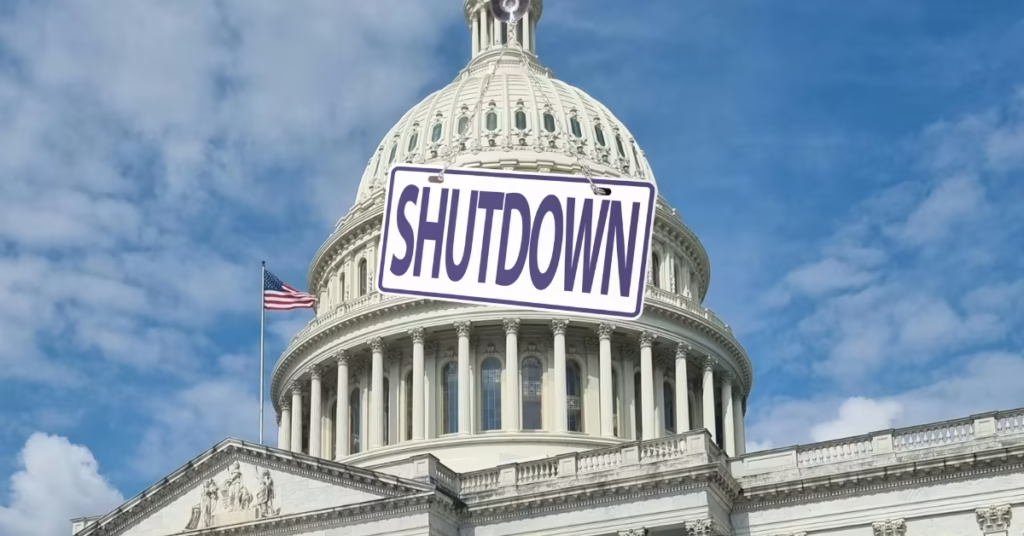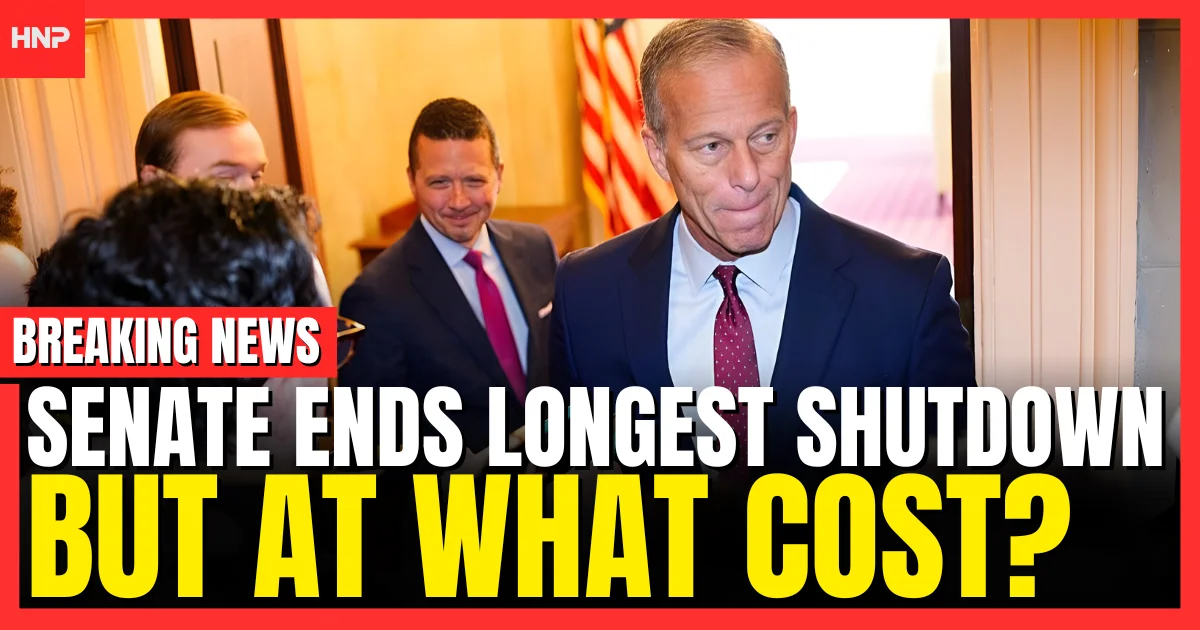Senate breaks 40-day shutdown deadlock with bipartisan deal. 1.4M workers await pay. Full breakdown of vote, timeline & what happens next.
Table of Contents
Senate Votes to End Record 40-Day US Government Shutdown: Complete Breakdown

Introduction
After more than five weeks of political deadlock, the United States Senate has approved a bipartisan measure designed to restore federal government operations. The Senate government shutdown vote marks a turning point in what has become the nation’s most prolonged funding crisis, affecting approximately 1.4 million workers across federal agencies.
Legislative leaders reached a compromise following intensive weekend discussions, with several Democratic senators breaking ranks to support the Republican-led initiative. This development offers the first concrete pathway to ending the federal operations freeze that began on the first day of October.
The agreement now advances through additional legislative stages, requiring House approval before implementation can begin and federal employees receive overdue compensation.
Senate Voting Results: Complete Data Breakdown
Understanding the Numbers Behind the Decision
The Senate’s procedural advancement required reaching a 60-vote supermajority threshold, necessitating cross-party cooperation given the chamber’s composition.
| Vote Category | Number | Percentage | Details |
|---|---|---|---|
| Total Votes Required | 60 | 100% | Procedural minimum threshold |
| Republican Seats | 53 | 53% | Majority party control |
| Votes Needed from Opposition | 7 | 11.7% | Minimum Democratic support required |
| Democrats Who Supported | 8 | 15.1% | Exceeded minimum requirement |
| Republicans Against | 1 | 1.9% | Sen. Rand Paul (Kentucky) |
| Final Vote Margin | 61-39 | 61% | Successful passage |
Key Negotiators and Their Roles
The compromise emerged from targeted discussions involving specific lawmakers with expertise in budget matters and constituent pressures.
| Negotiator | Party | Role | Primary Interest |
|---|---|---|---|
| John Thune | Republican | Senate Majority Leader | Government operations restoration |
| Jeanne Shaheen | Democrat | New Hampshire Senator | Healthcare subsidy guarantees |
| Maggie Hassan | Democrat | New Hampshire Senator | Federal worker protections |
| Angus King | Independent | Maine Senator | Bipartisan compromise |
| White House Representatives | Executive | Administration | Presidential priorities |
Senator Rand Paul’s opposition centered on fiscal responsibility arguments, specifically expressing concern about expanding federal debt obligations without corresponding spending reductions.
What the Funding Package Actually Contains

Point-by-Point Breakdown of Agreement Components
Rather than a single comprehensive measure, the legislative package combines multiple funding mechanisms addressing different priorities.
Component 1: Targeted Appropriations Bills
✅ Veterans Affairs Department
- Full funding for healthcare facilities
- Benefits processing restoration
- Claims backlog resolution resources
✅ Agriculture Department
- Rural development programs
- Farm loan servicing
- Food safety inspections
✅ Additional Federal Agencies
- Specific allocations for critical operations
- Restoration of suspended programs
- Administrative overhead funding
Component 2: Continuing Resolution Framework
📅 Temporary Funding Duration: Through January 30
- Provides six-week operational window
- Allows time for comprehensive budget negotiations
- Creates potential for renewed shutdown if no agreement reached
Component 3: Federal Worker Compensation Guarantee
💰 Back Pay Provisions:
- Retroactive compensation for all missed pay periods
- Applies to both furloughed and essential employees
- No distinction between employee categories
- Includes standard benefits continuation
Component 4: SNAP Program Protection
🍽️ Food Assistance Security:
- Supplemental Nutrition Assistance Program funded through September
- Protects benefits for 41 million Americans
- Prevents disruption to 12.5% of US households
- Ensures continued grocery assistance
Component 5: Healthcare Subsidy Commitment
🏥 Future Legislative Action:
- December vote scheduled on Affordable Care Act subsidies
- Addresses marketplace premium assistance expiring in 2024
- Non-binding commitment (no guaranteed passage)
- Primary Democratic negotiating priority
Impact Analysis: Who’s Affected and How
Federal Workforce Consequences
The extended funding lapse has created unprecedented financial strain across the federal employee population.
| Employee Status | Number Affected | Situation | Payment Status |
|---|---|---|---|
| Essential Workers (Working) | ~420,000 | Required on-the-job | Unpaid for 40 days |
| Furloughed (Home) | ~380,000 | Prohibited from working | Zero income received |
| Exempted Staff | ~600,000 | Funded through other mechanisms | Continued payment |
| Contractors | ~200,000 est. | No work available | No back pay guaranteed |
| Total Impacted | 1,400,000+ | Various circumstances | Varied outcomes |

Service Disruptions Across Government Functions
| Sector | Specific Impacts | Public Effect |
|---|---|---|
| Transportation | TSA security screening delays, FAA reduced operations | Longer airport wait times, flight certification delays |
| Nutrition Assistance | SNAP benefits at risk, WIC program funding uncertain | 41M Americans facing food insecurity |
| Parks & Recreation | National parks closed or limited services | Tourism industry revenue losses |
| Legal System | Federal court reduced hours, case delays | Justice system backlogs |
| Financial Services | IRS refund processing paused, SBA loan approvals halted | Tax season complications, small business funding gaps |
| Scientific Research | NASA projects paused, NIH grants delayed | Research timeline disruptions |
Political Dynamics: Why Some Democrats Broke Ranks
The Strategic Calculation
Eight Democratic senators chose to advance the Republican-led package despite party leadership opposition, creating internal friction.
Arguments FOR Supporting the Deal:
- Immediate Relief Priority
- Federal workers need paychecks urgently
- Extended deadlock causing severe hardship
- Moral obligation to restore income
- Healthcare Vote Commitment
- December legislative action scheduled
- Creates future negotiating opportunity
- Better than complete stalemate
- Political Positioning
- Demonstrates bipartisan cooperation capacity
- Avoids shutdown blame assignment
- Appeals to moderate constituents
- Practical Governance
- Essential services must function
- National security considerations
- Public safety requirements
Arguments AGAINST the Compromise:
- Insufficient Guarantees
- December vote is non-binding
- No concrete healthcare protections
- Surrendered negotiating leverage
- Short-Term Solution
- January 30 deadline creates new crisis point
- Doesn’t resolve underlying disputes
- Potentially repeats entire cycle
- Precedent Concerns
- Rewards shutdown tactics
- Weakens future negotiating position
- Encourages crisis governance
- Policy Substance
- Healthcare subsidies remain unresolved
- No progress on long-term priorities
- Purely procedural victory for Republicans
Notable Opposition Statements
Senate Minority Leader Chuck Schumer articulated the progressive position, emphasizing that procedural advancement without substantive policy wins represented a tactical error.
California’s Governor characterized the Democratic negotiators’ approach as inadequate given the leverage available from the prolonged crisis and Republican vulnerability.

Legislative Process: What Happens Next
Step-by-Step Path to Implementation
| Step | Timeline | Requirements | Potential Obstacles |
|---|---|---|---|
| 1. Senate Floor Debate | Monday, 11:00 AM local | Full discussion period | Amendments, procedural delays |
| 2. Final Senate Vote | Monday/Tuesday | Simple majority (likely) | Possible defections |
| 3. House Introduction | Tuesday/Wednesday | Speaker scheduling | Committee assignment battles |
| 4. House Committee Review | 24-48 hours | Appropriations Committee approval | Democratic amendments |
| 5. House Floor Vote | Wednesday/Thursday | 218-vote majority | Progressive/conservative opposition |
| 6. Presidential Signature | Within 24 hours | Executive approval | Veto unlikely but possible |
| 7. Implementation | 24-48 hours post-signature | Agency mobilization | Operational logistics |
House of Representatives Challenges
The lower chamber presents distinct political dynamics that could complicate passage:
Republican Considerations:
- Conservative members may demand spending cuts
- Border security funding could become leverage point
- Fiscal hawks concerned about debt implications
Democratic Considerations:
- Progressive caucus wants stronger healthcare guarantees
- Labor-aligned members prioritizing worker protections
- Leadership credibility on negotiating effectiveness
Procedural Factors:
- Amendment process more open than Senate
- Committee jurisdiction questions
- Time pressure as shutdown continues
Historical Context: Comparing Major Government Shutdowns
| Rank | Duration | Dates | Administration | Primary Issue | Employees Affected | Resolution |
|---|---|---|---|---|---|---|
| 1st | 40 days | Oct 1 – present | Current | Healthcare subsidies/budget | 1.4M | Pending |
| 2nd | 35 days | Dec 2018 – Jan 2019 | Previous admin | Border wall funding | 800,000 | Temporary CR |
| 3rd | 21 days | Dec 1995 – Jan 1996 | Clinton | Medicare/budget cuts | 284,000 | Bipartisan compromise |
| 4th | 16 days | Oct 2013 | Obama | Affordable Care Act | 800,000 | Clean CR passed |
| 5th | 5 days | Jan 2018 | Previous admin | Immigration policy | 692,000 | CHIP reauthorization |

What Makes This Shutdown Unprecedented
Key Differentiating Factors:
- Duration Severity
- Exceeds previous record by 5 days (14% longer)
- Compounds financial hardship exponentially
- Creates long-term retention challenges
- Scope of Impact
- Largest affected employee population
- Broader service disruptions
- More contractors involved
- Political Polarization
- Deeper partisan divisions
- Less compromise willingness initially
- Multiple failed negotiation attempts
- Economic Context
- Occurring during specific fiscal challenges
- Complicates existing budget pressures
- Affects economic growth projections
Economic Impact Assessment
Direct Financial Costs
| Impact Category | Estimated Cost | Affected Population | Long-Term Effect |
|---|---|---|---|
| Lost Federal Productivity | $3.2 billion | All agencies | Work backlog |
| Delayed Government Contracts | $1.8 billion | 200,000+ contractors | Business closures |
| Tourism Revenue Loss | $450 million | Park-dependent communities | Seasonal revenue gap |
| GDP Growth Reduction | 0.3% quarterly | Entire economy | Recovery lag |
| Consumer Spending Decline | $2.1 billion | Federal worker families | Ripple effects |
| Federal Back Pay | $4.7 billion | 1.4M employees | Immediate budget hit |
| Total Economic Impact | $12.3 billion+ | Multiple sectors | Ongoing consequences |
Indirect Economic Consequences
Small Business Sector:
- Government contractors facing cash flow crises
- Many operate on thin margins with federal contracts
- Potential bankruptcies and permanent closures
- Difficulty securing bridge financing
Real Estate Market:
- Federal loan approvals halted (FHA, VA mortgages)
- Delayed home purchases and refinancing
- Title verification processes interrupted
- Market uncertainty affecting transactions
Local Economies:
- Communities near federal facilities especially vulnerable
- Reduced consumer spending in affected areas
- Service industry businesses losing revenue
- Multiplier effects throughout regional economies
Investment Climate:
- Uncertainty discourages business expansion
- International perception of US stability
- Credit rating considerations
- Market volatility concerns

Future Outlook: January Deadline Looms
Why Another Shutdown Could Happen
The current agreement only extends funding through January 30, creating a compressed timeline for comprehensive negotiations.
| Date | Event | Significance | Risk Level |
|---|---|---|---|
| Dec 15-20 | Healthcare subsidy vote | Tests Democratic negotiating win | Medium |
| Jan 1-15 | Budget negotiation intensive period | Determines long-term agreement feasibility | High |
| Jan 25 | Deadline for compromise framework | Last chance for orderly transition | Critical |
| Jan 30 | Funding expiration | Government shuts down again if no deal | Very High |
| Feb-Mar | Debt ceiling deadline | Additional fiscal crisis potential | Extreme |
Scenarios for January Negotiations
Best Case Scenario:
- Comprehensive appropriations bills passed
- Healthcare subsidies extended permanently
- Full-year funding certainty achieved
- Bipartisan cooperation continues
Moderate Case Scenario:
- Another short-term continuing resolution
- Healthcare compromise with partial extensions
- Funding through end of fiscal year
- Continued political tension
Worst Case Scenario:
- Negotiations collapse completely
- Second shutdown beginning January 31
- Federal workers face renewed uncertainty
- Economic confidence deteriorates further
❓ FREQUENTLY ASKED QUESTIONS
What exactly did the Senate vote accomplish regarding the shutdown?
The Senate passed a procedural motion advancing legislation to restore government funding after 40 days of shutdown. This vote (61-39) allows the bill to move forward for full consideration, but does not immediately end the shutdown. The measure still requires a final Senate vote, House of Representatives approval, and presidential signature before federal operations can resume and employees receive back pay.
When will federal employees actually receive their paychecks?
Federal employees will receive back pay once the funding bill completes the entire legislative process and is signed into law. The timeline depends on House passage speed, but workers could potentially see payment within 5-7 business days after final enactment. Payment will include all missed pay periods retroactively, covering the complete 40-day shutdown duration for both furloughed workers and those required to work without compensation.
Does this deal prevent future government shutdowns?
No, the current agreement only funds government operations through January 30, creating a six-week window before another potential shutdown. Congress must negotiate a comprehensive long-term funding solution before that deadline, or the shutdown crisis could repeat. The short-term nature of this continuing resolution means federal workers and agencies face ongoing uncertainty about operations beyond late January.
What happens to government contractors during and after the shutdown?
Government contractors face significantly different circumstances than direct federal employees. While the agreement guarantees back pay for federal workers, contractors typically receive no compensation for shutdown periods when they couldn’t work. Many contractor employees had to use vacation time, find temporary work, or go without income entirely. Even after government reopening, contract work resumption depends on individual contract terms and agency priorities.
How did Democrats justify voting with Republicans on this deal?
The eight Democrats who supported the measure cited several justifications: immediate financial relief for struggling federal workers, a commitment to vote on healthcare subsidies in December, and the necessity of restoring essential government services affecting millions of Americans. They argued that prolonging the shutdown caused more harm than accepting a compromise with future negotiating opportunities. Critics within their party contend they surrendered leverage without securing concrete policy guarantees.
What is the likelihood of another shutdown starting January 31?
The probability of another shutdown depends on whether negotiators can reach comprehensive agreement within six weeks while also addressing the December healthcare subsidy vote. Historical patterns suggest continuing resolutions often lead to additional short-term extensions rather than permanent solutions. Political analysts estimate a 35-40% chance of another shutdown in late January unless substantial progress occurs quickly on underlying budget disagreements.
🎯 CONCLUSION
The Senate’s bipartisan advancement of shutdown-ending legislation represents meaningful progress after 40 days of federal operations paralysis. However, characterizing this as a complete resolution would be premature given the multiple legislative hurdles remaining and the short-term nature of the funding extension.
Approximately 1.4 million federal employees await final Congressional action that could restore their paychecks and return suspended government services to normal operations. The agreement demonstrates that even in highly polarized political environments, sufficient pressure can produce compromise—though whether that compromise adequately addresses underlying disputes remains contentious.
The January 30 funding deadline creates urgency for comprehensive negotiations while simultaneously raising the possibility that this entire crisis could repeat within weeks. Federal workers, government contractors, and Americans dependent on federal services will be watching closely as the House considers this measure and longer-term budget discussions unfold.
Critical Next Steps to Monitor:
✔️ House of Representatives vote timing and result
✔️ Presidential response and signature timeline
✔️ December healthcare subsidy vote outcome
✔️ January comprehensive funding negotiations
✔️ Federal employee payment processing speed
Stay informed on this developing situation by bookmarking this analysis and checking back for updates as legislative action progresses through remaining stages.
Have questions about how the shutdown affects specific federal services or your situation? Drop your questions in the comments below for detailed answers.


